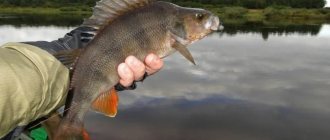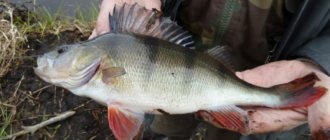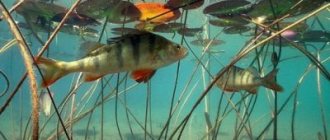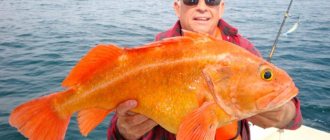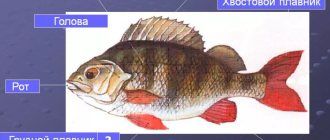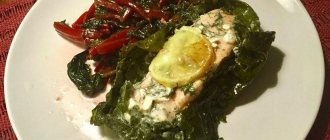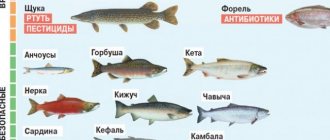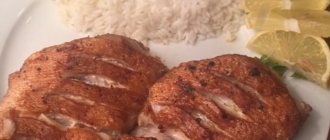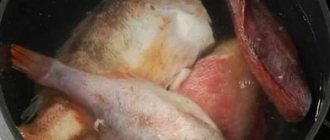Perch differs from other orders in the structure of the dorsal fin - it consists of two parts, of which the front part is spiny, and the back is softer. In some individuals, fusion of two parts is observed. As for the anal fin, it contains from one to three spines. In the tail there is a kind of recess. The pelvic fins most often have red tints. Perch has surprisingly large teeth, located in a large mouth, arranged in several rows; some individuals also have fangs. Dense scales adjacent to the skin with dark stripes. At the back is a ridge, it consists of teeth or spines. The cover of the gills consists of small serrations.
The weight of the fish varies from 450g to 3 kg, when the weight of huge sea fish reaches 15 kg. The fish can be more than a meter in length, but on average it is about 40 cm. Perches are hunted by large predators, such as otters and herons, including humans.
The color of perch varies depending on the species, most often green-yellow and gray-green. Marine fish often have red hues. They come in yellow or bluish color. Deep-sea fish have large eyes.
In the nineteenth and twentieth centuries, the habitat of the perch fish has a huge potential for life, most often due to the introduction into other bodies of water; the perch appears in the reservoirs of Spain, China, New Zealand and other countries. The perch fish is considered to be acclimatized in the Ebro River basin, Spain.
Types of perches
The perch family consists of more than 100 species. On the territories of countries that were formerly part of the USSR, several species are represented:
- river perch - most often found in all fresh water bodies;
- yellow perch - these fish have fins, tails and yellow scales;
- Balkhash perch has a dorsal fin without dark spots, and adult representatives do not have vertical stripes;
- sea bass - all fin needles have poisonous glands.
Perch size
The size of river perch can be no more than 50 cm, weighing 2 kg, but some species are also larger. The size of perches may vary in different bodies of water. The average size of an adult perch can reach 20 cm. The lifespan of a river perch can be 20 years. Factors such as age and size directly depend on the specific body of water in which there are many perches. There are two types of fish: small, slow-growing fish known as grass perch, and large, deep-dwelling perch, which can already reach 100 grams at the age of four and lives in the open part of lakes.
Perch spawning
Perch spawning is most often observed in the spring, which is the most important cycle in life. During this period, perch fish do not respond to all kinds of bait. That is why anglers try to distinguish between the life cycles of perch. After the ice on the reservoirs melts, the fish leave their winter resting places, after which they gather in schools and go to shallow waters. During this period, in the shallow water there are heaps of white fish of different sizes, preparing for spawning. At this time, deep-sea perch goes hunting - “pre-spawning zhor”. Perch can be caught using any live bait. Zhor takes about a week. One of the conditions for spawning is the temperature of water and air.
This cycle in the life of a perch directly depends on the water temperature. That is why it is impossible to clearly name the month of spawning. As soon as the temperature reaches 8 degrees, the bite stops taking place.
The next condition will be oxygen and its saturation in water. That is why the absence of ice is a prerequisite. Deep-sea and grass perches choose different places for spawning, so the timing of spawning varies significantly.
Features of reproduction
Perch becomes a sexually mature predator only at 2-3 years of age. Before spawning begins, the fish gather in schools and move to shallow water, where they will spawn. The spawning period begins immediately after the ice disappears. Before spawning, the color of the fish becomes brighter.
Place and time of spawning
Spawning begins when the water warms up to +8°C. An important factor is the absence of ice, in which case there is a sufficient amount of oxygen in the water.
To spawn, the fish go to shallow water, so sometimes, if you look closely, you can see a perch rubbing against a stone or a dried aquatic plant. Thus, eggs fertilized by the male are deposited.
The process takes place at sunrise. Sometimes spawning can resume in the evening. Large individuals spawn on their own; they do this in deeper places. Spawning of large species occurs later than that of small ones.
In what month does it spawn?
The beginning of spawning is observed in March - April. The exact time depends on the climate zone, species and weather conditions. The fish begin to spawn at sunrise, this process can last about 3 days or more.
How many eggs does it lay?
At one time, a female can lay about 300 thousand eggs. Their exact number depends on the age and size of the fish itself. Such fish have a very low survival rate. A large amount of caviar is eaten by waterfowl, and part of the caviar is eaten by the perch itself.
The fry appear after 20-25 days. At first, they feed only on plankton that floats in coastal waters. When an individual grows to 10 cm in length, it becomes a predator.
Perch habitats
The habitats of perch are in almost all reservoirs located in the Northern Hemisphere. For comfortable life of perch, several conditions are necessary - weak currents, medium depths and underwater vegetation. Perches can form schools and live in lakes at depths of up to 150 m.
At the boundaries of large bodies of water, fish can form local herds and divide into two large populations. Fish most often live in flat bodies of water, such as a river, lake, pond or reservoir. There are reservoirs where perch is the only species of fish.
Perch is mainly found in the coastal part of the reservoir, where there is the most algae and so on, or in the environment of artificial obstacles. An unfavorable temperature for reproduction of an individual is water above 32-33 °C.
Breeding
Breeding perch is beneficial for other pond inhabitants. This is explained by the fact that in reservoirs there are species of fish that destroy the eggs of other individuals, thereby preventing their reproduction. The perch will destroy such parasites.
However, there is a risk that a gudgeon or loach may eat the eggs of the perch itself, thereby preventing its further reproduction.
To protect perch eggs, a person needs to create certain conditions. In March, when spawning begins, it is necessary to lay out branches and snags along the shore so that the perch lay their eggs there. To protect the fish from pests, you should fence this area with a fine mesh.
IMPORTANT. When breeding perch, you should take into account the requirements regarding the quality of water and the bottom of the reservoir.
It will not live in a muddy pond that freezes almost to the bottom. In order for the fish to have access to oxygen, small ice holes need to be made in winter. Otherwise, the perch will suffocate from insufficient air and excess gases produced by the algae.
When breeding perch, you should understand that it poses a threat to carp. It destroys its eggs and offspring.
In order for fish to feel good in an artificial pond, it is necessary to create good conditions. Special cleaning devices should be installed that will ensure an optimal level of aeration.
You need to think about your diet. For this purpose, you can specifically bring in fish and fry. Bloodworms, maggots and worms are perfect for artificial feeding.
Breeding in an artificial pond has the following advantages:
- the perch plays the role of an orderly, this contributes to the normalization of the ecosystem;
- the fish are active all year round, so you can go fishing at any time;
- With proper cultivation and maintenance, you can get good financial benefits.
Before breeding perch in a pond, it is necessary to study all the intricacies of its maintenance, as well as its proximity to other fish.
Perch lifestyle
A predatory perch, it can often be prey to more predatory fish, such as catfish, pike or burbot. In turn, it feeds on any fish, as long as it is suitable in size. And since the perch has a rather huge mouth, the river perch can eat particularly large fish without much difficulty. It also hunts molting crayfish that have lost their shell, eggs, and aquatic insects.
Perch leads a fairly active lifestyle. The fish begin to hunt in the morning. On sunny days, the fish stands in dense underwater vegetation, avoiding the heat and sunlight, and ambushes its prey. Summer days of river perch depend on the lack of food. In winter, perch goes to a depth of up to 50 meters. Rivers and ponds must have a layer of unfrozen water so that fish can swim. Ice holes are necessary to support the life of the perch.
Perch is a particularly voracious fish. If a perch sees a large school of fish, without swallowing the first one, it swallows the second, third, fourth, and so on. Sometimes the perch's stomach becomes completely clogged, and small fish stick out straight from the mouth. It is believed that pike causes enormous damage to perch. But the perch tries not to give in, turning the game over more often. The fish respects cool water and does not consider it acceptable to swim on the surface of the reservoir, but if a fish appears, the perch rises from the depths without hesitation.
Perch spawns in the south of the country in April, and in the north in May; most often the cycle can be delayed and some species can be found even in June.
How to catch a freshwater robber
For many centuries, winter perch (and not only it) have been caught by absolutely any means. Thanks to the development of various technologies and skills, fishermen constantly invented some new ways of catching this fish, while increasing their efficiency each time.
People diligently monitored the habits of this species and tried to listen as carefully as possible to its tastes. Thus, the habits of this predator were revealed to man, and this allowed him to learn to predict its movements.
Read here Danube salmon - where, how and when to catch? Review of baits and gear necessary for salmon fishing (125 photos and videos)«>
Well, as for today, the twenty-first century offers fishermen to use such products as:
- Types of various spinning rods (for example, twitching or dropshot). The most popular type of fishing;
- Regular bottom tackle. Here you can recall such options as picker, zakidushka or half-bottom. Donke fishing is very common among beginners;
- Float rod;
- Special gear designed for fishing in the cold season. A jig or spinner works well here.
If the fishing process takes place far from the shore and in this place there is a fast current combined with a rocky bottom, then the fish is hunted using fly fishing.
In general, any of the listed methods is good in its own way. The most important thing for a person is to understand which method he likes best.
Life cycle of a perch
In spring, perch's food intake can range from late March to early April. Guided by this, we are accustomed to calling two periods – pre-spawning zhor and post-spawning. In the first case, the zhor begins long before the ice melts. Perch eats up before spawning. Usually, by the beginning of spawning, the reservoir is deprived of ice. Usually fishing during this period occurs with winter gear. The second zhora usually begins at the end of May. During this period, spawning of small fish just ends. And the recovery period for fish is very fast.
In summer, perch's appetite weakens significantly. Now there is no need for food compared to pre-spawning periods. In summer, perch has no zhor, just like pike does.
In autumn, when winter approaches, the fish's appetite increases. The activity of the fish increases, this is justified by the fact that the fish needs to gain fat during a difficult period. Perch begins its autumn feeding at the end of September, when the water temperature drops below 10 degrees.
At the end of autumn, ice begins to form on reservoirs. In winter, fishing usually begins in early November. The winter fat of perch directly depends on the tranquility of the reservoir, because only when the waves stop flowing, ice fills the entire surface of the lake, the fish begins to walk in shallow water, and comes to a distance accessible to the fisherman. As it gets colder, the fish sink to depth, which means only one thing – the winter glutton of perch is coming to its logical conclusion.
Perch nutrition
Perch fry feed on zooplankton, depending on their age, they begin to feed on benthic organisms, and then prey on young fish. The fish feeds on fry in the second year of life. The feeding method of fish is characteristic of facultative predators. Depending on the lake, the food of fish of the same age may vary due to differences in the composition of the food. Most fish eat narrow-bodied fish. More often, stickleback, minnow, roach, and also sprat become victims of perch. Perch fish is a supporter of cannibalism; sometimes adult fish eat young fish. Perch eats insect larvae, frogs and crayfish. Perches are the most well-fed in summer and autumn; the fish actively feed in preparation for winter.
Algae, pieces of bark, and small stones are often found in the stomachs of perches. It is known that fish swallow them accidentally, along with benthic organisms, fish, crayfish and larvae, but there are versions that tell us that these minor objects are necessary for perches as digestive enzymes.
With prolonged starvation, perch fish quickly lose weight and subsequently die earlier than other predators, such as catfish or pike.
Spawning
Sexual maturity of perch occurs at three years of age. At this time, the body size is 10 cm. The timing of spawning differs depending on the region where the fish lives. In the south it is the end of February, in the central part of Russia and the Volga region it is April, in the north of the country it is May.
For perch to begin spawning, the water must warm up to a temperature of 7-8°C. Spawning duration is 4-9 days.
All perches are valued for their taste. Is perch an oily fish or not? More likely no than yes. It is added to fish soup, fried, dried, smoked.
There are many interesting dishes that can be prepared using its meat. Therefore, do not be lazy to go fishing for this fish.
Methods of catching perch
As soon as the reservoir is covered with ice, the perch bite is the most active. It occurs when the ice is still ultra-thin. Since schools of striped fish have not yet established themselves in certain places, perch are biting throughout the entire area of the reservoir. First of all, the entire plane is examined, because the fish can stop anywhere.
There are several ways to catch perch in winter, such as: drilling with a zigzag, the same envelope, placing live bait fishing rods, under-ice echo sounder, group research. Each of the methods is a very important assistant in finding perch both at depth and in small bodies of water.
The fishing gear for perch can be a marmy with a bait, a reelless bait, a perch bait, a live bait fishing rod, or a spinner. With jig gear for perch, everything is clear, the first one is attached with a bloodworm, the second one works without attachments, provoking and luring the perch. Lure tackle - balancers, spoons, amphipods, silicone baits, flies, cicadas.
In the summer habitats of the fish, fishermen successfully catch it with spinning rods and large lures for perch. The spoon is cast in the bottom layer, close to stones, koryak, and so on. Subsequent casts are made closer to the school of caught fish and their movements are monitored.
On weak currents or reservoirs where the water is in a calm state, summer fishing for perch using a winter lure in a plumb line from a motor boat. In summer you can fish with a jig and a long fishing rod.
The bottom topography is of great importance. Usually the fish is in the bottom layer of the reservoir, so using a depth gauge, you can track the depth of the nozzle, which is held depending on the immersion of 20 centimeters from the bottom. Sometimes perch is found in the upper layers of a reservoir, for example, it is caught while hunting for fry.
What does perch eat?
The diet of perch is determined by the availability of prey, its size, and number. There is no denying that perch is a predatory fish. However, in most cases he has to eat various small things. Even after reaching adulthood.
In the first year of life, perch fry consume plankton. The juveniles start feeding on benthos in the second year of life. By this time, their gastrointestinal tract is already ready to consume benthic invertebrates. These include larvae of mosquitoes, caddisflies, and other insects.
Growing to a size of 13-15 cm, juvenile perch begins to engage in predation. During this period, perch cannibalism begins to develop. It is at this stage that the division into “grass” and “sea” (deep) begins. The first migration to the depths and to the shore puts its end. Perch remaining in wintering areas becomes a real predator earlier. Those that have returned to their summer camps begin to eat benthos and fish larvae.
However, here you need to take into account that the reservoirs are different. Just like their population. Lakes inhabited exclusively by perch will definitely be inhabited by cannibals. The attraction (need) to hunt for relatives in this case is revealed already in the first year of life.
As for large perches, they will not disdain to eat dragonfly larvae. However, they are not destined to feed their growing body on boogers. Humpback whales need normal, complete food. Fish, crayfish, frogs. Moreover, the percentage of one or another type of food can be quite impressive. For example, studies of Volga perches in the mid-80s revealed that the diet of perch includes 20% crayfish.
Thus, perch is a predatory fish. The diet is very varied. It is determined by the size of the fish, the availability of food, and areas of residence in the reservoir. Naturally, this must be taken into account when going fishing.
Perch dishes
Baked perch in foil
e -
lovers of fish dishes will appreciate river perch baked in foil; even an inexperienced housewife can handle the preparation.
Perch with
potatoes in the oven
-
the fish is baked in the oven along with potatoes, onions, mushrooms, sour cream and spices.
Fried sea bass in batter
—
the fish is fried in batter until golden brown, then served with sauce to taste.
Sea bass with vegetables
—
the fish is cut into pieces and stewed with tomatoes and onions.
Perch soup
on the fire -
fish soup is a national dish.
It is an integral part of outdoor recreation. Fish sticks with spicy sauce
—
pieces of fish are breaded and fried in oil.
Sea bass with lemon sauce
—
sea bass meat is quite soft and aromatic, and fried grouper in lemon sauce is a delicacy.
Diet
It is so omnivorous and voracious that the complete answer to the question of what perch eats looks like this - everything that fits in its wide, toothy mouth. The river feasts on zooplankton, benthic organisms, small fish, eggs of other fish, crustaceans, larvae, worms, insects, etc. There are often cases when perch considers relatives, frogs and even algae as food.
The basis of the predator’s fish diet is left by representatives of the carp family (Cyprinidae):
- gudgeon, roach, crucian carp;
- minnow, bream, bleak;
- rudd, verkhovka, roach:
- Podust, Chekhon, Chebak.
In practice, the situation arises that any fish 2-12 cm long that lives next to a perch is included in its zone of hunting interests, including the closest single-family species - pike perch, ruffe, chop.
To learn more:
Bream: description of fish, habitat and habits
